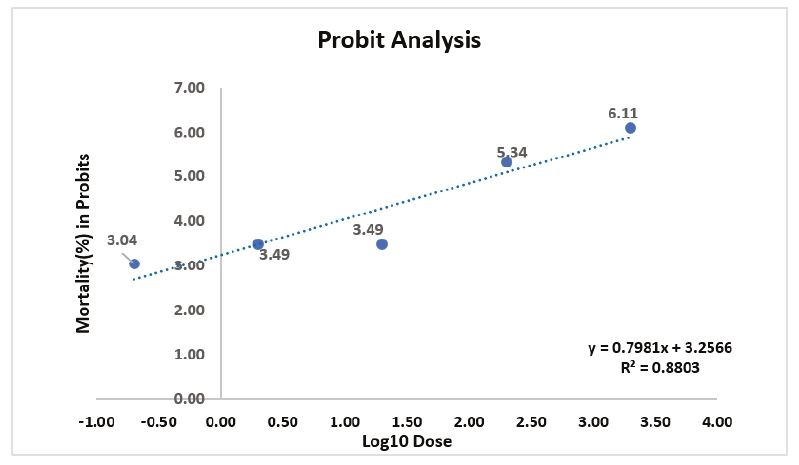Physical and bio-control methodologies for integrated management of buffalo fly-Haematobia exigua (Diptera: Muscidae)
DOI:
https://doi.org/10.56825/bufbu.2023.4244314Keywords:
Bubalus bubalis, buffaloes, Haematobia exigua, bacterial bio-control agents, integrated pest managementAbstract
Haematobia exigua, the buffalo fly, is a common ectoparasite of buffaloes and cattle in India causing economic losses and underlines the necessity of effective control strategies against them. The present study was planned to evaluate larvicidal activity of few methods for physical and biological control for integarated management of Haematobia exigua flies. Out of four bacterial bio-control agents evaluated by in-vitro assay and Probit analysis, two bacteria i. e. Bacillus thuringiensis var israelensis and Bacillus thuringiensis var kurstaki showed excellent larvicidal activity against H. exigua with LC50 value of 134 and 135 mg per liter of water respectively. Whereas, other two bacteria i. e. Bacillus weihenstephanensis WSBC and KBAB4 failed to show desired larvicidal activity. It can be concluded that B ti and B tk have future as effective bacterial agents (BCAs) in the control and integrated management of buffalo and horn fly. An experiment was conducted in the laboratory and on field for judging the efficacy of a physical method of tightly covering dung pats with polythene sheet for control of larvae of H. exigua. The laboratory result showed only 14.73% larvae were survived and developed per 100 gm of the faeces in the pot covered with polythene sheet as against significantly higher number 78.33% in the control group. During field trial, average larval count from dung pits before the experiment was 86.33 per 250 gm of faeces and it has been significantly reduced to 11.80 after covered with polythene sheets for two weeks. It indicated that physical method of covering the dung pits works immensely and thus can be inducted in IPM program as one of the effective physical control alternatives.
Downloads
Metrics
References
Baker, G.T. 1987. Morphological aspects of the third instar larva of Haematobia irritans. Med. Vet. Entomol., 1(3): 279-283. DOI: 10.1111/j.1365-2915.1987.tb00355.x
Banks, H.J. 1976. Physical control of insects-recent developments. Aust. Entomol., 15(1): 89-100. Available on: https://onlinelibrary.wiley.com/doi/pdf/10.1111/j.1440-6055.1976.tb02079.x
Byford, R.L., M.E. Craig and B.L. Crosby. 1992. A review of ectoparasites and their effect on cattle production. J. Anim. Sci., 70(2): 597-602. DOI: 10.2527/1992.702597x
Du Toit, R. 1938. The horn fly (Lyperosia minuta) in South Africa. J. S. Afr. Vet. Assoc., 9(3): 136-143. Available on: https://journals.co.za/doi/pdf/10.10520/AJA00382809_116
Finney, D.J. 1952. Probit Analysis, 2nd ed. Cambridge University Press, New York, USA.
Fitzpatric, D. and P.E. Kaufman. 2011. Featured Creatures- Horn Fly. University of Florida, Florida, USA. Available on: http://entnemdept.ufl.edu/creatures/livestock/flies/horn_fly
Foil, L.D. and J.A. Hogsette. 1994. Biology and control of tabanids, stable flies and horn flies. Rev. Sci. Tech. OIE., 13(4): 1125-1158. DOI: 10.20506/rst.13.4.821a
Gough, J.M., R.J. Akhurst, D.J. Ellar, D.H. Kemp and G.L. Wijffels. 2002. New isolates of Bacillus thuringiensis for control of livestock ectoparasites. Biol. Control., 23(2): 179-189. DOI: 10.1006/bcon.2001.1006
Gudewar, J.G., B.W. Narladkar, H.Y. Palampalle and S.R. Rajurkar, 2020. In-vitro evaluation of three herbal oils against larval stages of Lyperosia-Haematobia complex (Diptera: Muscidae). Journal of Entomology and Zoology Studies, 8(2): 1169-1174. Available on: https://www.entomoljournal.com/archives/2020/vol8issue2/PartT/8-2-159-939.pdf
Haufler, M. and S.E. Kunz. 1985. Laboratory evaluation of an exotoxin from Bacillus thuringiensis Subsp. morrisoni to horn fly larvae (Diptera: Muscidae) and mice. J. Econ. Entomol., 78(3): 613-616. DOI: 10.1093/jee/78.3.613
Lysyk, T.J., L.D. Kalischuk-Tymensen, K. Rochon and L.B. Selinger. 2010. Activity of Bacillus thuringiensis isolates against immature horn fly and stable fly (Diptera: Muscidae). J. Econ. Entomol., 103(3): 1019-1029. DOI: 10.1603/ec10018
Metcalf, R.L. and R.A. Metcalf. 1993. Destructive and Useful Insects, 5th ed. McGraw-Hill, New York, USA.
Pinnock, D.E. 1994. The use of Bacillus thuringiensis for control of pests of livestock. Agr. Ecosyst. Environ., 49(1): 59-63. DOI: 10.1016/0167-8809(94)90023-X
Saparov, K.A., F.D. Akramova, D.A. Azimov and V.I. Golovanov. 2014. Study of biology, morphology and taxonomy of the nematode Stephanofilaria assamensis (Filariina, Stephanofilariidae). Vestnik Zoologii, 48(3): 269-274. DOI: 10.2478/vzoo-2014-0030
Sharma, A.K., A. Nandi, S. Kumar, A. Fular and S. Ghosh. 2018. Practical manual-Advances in the management of drug resistance in economically important parasites. IVRI Publication, Bareilly, India. p. 39-43.
Shaw, S.A. and I.A. Sutherland. 2006. The prevalence of Stephanofilaria sp. in buffalo fly, Haematobia irritans exigua, in Central Queensland. Aust. J. Entomol., 45(3): 198-201. DOI: 10.1111/j.1440-6055.2006.00545.x
Temeyer, K.B. 1984. Larvicidal Activity of Bacillus thuringiensis subsp. israelensis in the Dipteran Haematobia irritans. Appl. Environ. Microb., 47(5): 952-955. DOI: 10.1128/aem.47.5.952-955.1984
Williams, J.D., R.W. Sutherst, G.F. Maywald and C.T. Petherbridge. 1985. The southward spread of buffalo fly (Haematobia irritans exigua) in eastern Australia and its survival through a severe winter. Aust. Vet. J., 62(11): 367-369. DOI: 10.1111/j.1751-0813.1985.tb14210.x









.png)








